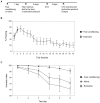Fear memory formation can affect a different memory: fear conditioning affects the extinction, but not retrieval, of conditioned taste aversion (CTA) memory
- PMID: 25324744
- PMCID: PMC4179742
- DOI: 10.3389/fnbeh.2014.00324
Fear memory formation can affect a different memory: fear conditioning affects the extinction, but not retrieval, of conditioned taste aversion (CTA) memory
Abstract
The formation of fear memory to a specific stimulus leads to subsequent fearful response to that stimulus. However, it is not apparent whether the formation of fear memory can affect other memories. We study whether specific fearful experience leading to fear memory affects different memories formation and extinction. We revealed that cued fear conditioning, but not unpaired or naïve training, inhibited the extinction of conditioned taste aversion (CTA) memory that was formed after fear conditioning training in rats. Fear conditioning had no effect on retrieval of CTA memory but specifically impaired its extinction. Extinguished fear memory, after fear extinction training, had no effect on future CTA memory extinction. Fear conditioning had no effect on CTA memory extinction if CTA memory was formed before fear conditioning. Conditioned taste aversion had no effect on fear conditioning memory extinction. We conclude that active cued fear conditioning memory can affect specifically the extinction, but not the formation, of future different memory.
Keywords: conditioned taste aversion; cued fear conditioning; learning and memory; memory extinction; memory retrieval.
Figures




Similar articles
-
Differential effects of thirst and satiety on conditioned taste aversion acquisition, retrieval, and memory extinction.Physiol Behav. 2023 Jun 1;265:114143. doi: 10.1016/j.physbeh.2023.114143. Epub 2023 Mar 8. Physiol Behav. 2023. PMID: 36898644
-
Memory of conditioned taste aversion is erased by inhibition of PI3K in the insular cortex.Neuropsychopharmacology. 2013 Jun;38(7):1143-53. doi: 10.1038/npp.2013.20. Epub 2013 Jan 16. Neuropsychopharmacology. 2013. PMID: 23385661 Free PMC article.
-
Different mechanisms of extinction of conditioned taste aversion are dependent on time intervals of extinction following conditioning.Naturwissenschaften. 2012 Mar;99(3):185-9. doi: 10.1007/s00114-012-0883-7. Epub 2012 Jan 25. Naturwissenschaften. 2012. PMID: 22274636
-
Another Example of Conditioned Taste Aversion: Case of Snails.Biology (Basel). 2020 Nov 26;9(12):422. doi: 10.3390/biology9120422. Biology (Basel). 2020. PMID: 33256267 Free PMC article. Review.
-
Activation of the hypothalamic-pituitary-adrenal axis in lithium-induced conditioned taste aversion learning.Eur J Pharmacol. 2015 Dec 5;768:182-8. doi: 10.1016/j.ejphar.2015.10.052. Epub 2015 Oct 30. Eur J Pharmacol. 2015. PMID: 26524411 Review.
Cited by
-
The Insula and Taste Learning.Front Mol Neurosci. 2017 Nov 3;10:335. doi: 10.3389/fnmol.2017.00335. eCollection 2017. Front Mol Neurosci. 2017. PMID: 29163022 Free PMC article. Review.
-
The formation and extinction of fear memory in tree shrews.Front Behav Neurosci. 2015 Jul 29;9:204. doi: 10.3389/fnbeh.2015.00204. eCollection 2015. Front Behav Neurosci. 2015. PMID: 26283941 Free PMC article.
References
-
- Akirav I., Khatsrinov V., Vouimba R. M., Merhav M., Ferreira G., Rosenblum K., et al. (2006). Extinction of conditioned taste aversion depends on functional protein synthesis but not on NMDA receptor activation in the ventromedial prefrontal cortex. Learn. Mem. 13, 254–258 10.1101/lm.191706 - DOI - PMC - PubMed
LinkOut - more resources
Full Text Sources
Other Literature Sources

